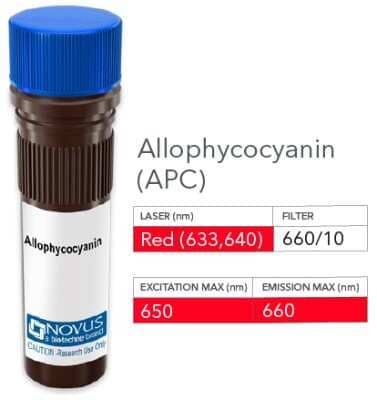Fc gamma RIII (CD16) Antibody (5B11) [Allophycocyanin]
Novus Biologicals, part of Bio-Techne | Catalog # NBP2-42228APC


Conjugate
Catalog #
Forumulation
Catalog #
Key Product Details
Species Reactivity
Human, Mouse, Rat
Applications
ELISA, Flow Cytometry, Immunocytochemistry/ Immunofluorescence, Immunohistochemistry, Immunohistochemistry-Frozen, Immunoprecipitation, Microarray
Label
Allophycocyanin (Excitation = 620-650 nm, Emission = 660-670 nm)
Antibody Source
Monoclonal Mouse IgG2A Clone # 5B11
Concentration
Please see the vial label for concentration. If unlisted please contact technical services.
Product Specifications
Immunogen
Raised against CD16 antigen
Reactivity Notes
Mouse blocking reagent may be needed for IHC and ICC experiments to reduce high background signal. You can find these reagents under catalog numbers PK-2200-NB and MP-2400-NB. Please contact Technical Support if you have any Please note that this antibody is reactive to Mouse and derived from the same host, Mouse. Mouse-On-questions.
Specificity
Recognizes CD16 antigen
Clonality
Monoclonal
Host
Mouse
Isotype
IgG2A
Scientific Data Images for Fc gamma RIII (CD16) Antibody (5B11) [Allophycocyanin]
Product Image: Fc gamma RIII (CD16) Antibody (5B11) [Allophycocyanin] [NBP2-42228APC] - Vial of APC conjugated antibody. APC is optimally excited at 650 nm by the Red laser (633 or 640 nm) and has an emission maximum of 660 nm.
Applications for Fc gamma RIII (CD16) Antibody (5B11) [Allophycocyanin]
Application
Recommended Usage
ELISA
Optimal dilutions of this antibody should be experimentally determined.
Flow Cytometry
Optimal dilutions of this antibody should be experimentally determined.
Immunocytochemistry/ Immunofluorescence
Optimal dilutions of this antibody should be experimentally determined.
Immunohistochemistry
Optimal dilutions of this antibody should be experimentally determined.
Immunohistochemistry-Frozen
Optimal dilutions of this antibody should be experimentally determined.
Immunoprecipitation
Optimal dilutions of this antibody should be experimentally determined.
Microarray
Optimal dilutions of this antibody should be experimentally determined.
Application Notes
Optimal dilution of this antibody should be experimentally determined.
Formulation, Preparation, and Storage
Purification
Protein G purified
Formulation
PBS
Preservative
0.05% Sodium Azide
Concentration
Please see the vial label for concentration. If unlisted please contact technical services.
Shipping
The product is shipped with polar packs. Upon receipt, store it immediately at the temperature recommended below.
Stability & Storage
Store at 4C in the dark.
Background: Fc gamma RIII (CD16)
Fc gamma RIIIA/CD16a is expressed as a transmembrane protein on NK cells and on a subset of monocytes, macrophages, CD4+T cells, basophils, and mast cells (1-3). Fc gamma RIIIB/CD16b is primarily expressed on neutrophils as a glycosylphosphatidylinositol (GPI)-anchored protein but is also expressed on a subset of basophils and can be induced on eosinophils (1-3). The soluble form of CD16 (sCD16) which is often produced following exposure to inflammatory signals and protein shedding via metalloproteinases (3). Reduced sCD16 levels have been found in patients with multiple myeloma (3).
Activating NK cell receptor function has been harnessed for its potential in tumor immunotherapy (6). One immunotherapy strategy is using bi- and tri-specific NK cell engagers (BiKE and TriKE) to target the Fc gamma RIIIA/CD16a receptor with tumor-associated antigens to stimulate a cytotoxic response and mount an attack on tumor cells (6). CD16a is also capable of antibody dependent cellular cytotoxicity (ADCC) through recognition of antibodies bound to target cells (6-7). CD16-induced NK cell activation allows for NK co-receptor expression including stimulatory receptors like CD137 or inhibitory receptors like TIGIT and PD-1, which serve as additional regulatory checkpoints during ADCC (7). Therapeutic antibodies for cancer treatment like rituximab or trastuzumab can be recognized by Fc gamma RIIIA/CD16a to activate NK cell-mediated killing of tumor cells (6-7).
References
1. Fossati, G., Bucknall, R. C., & Edwards, S. W. (2001). Fcgamma receptors in autoimmune diseases. European Journal of Clinical Investigation, 31(9), 821-831. https://doi.org/10.1046/j.1365-2362.2001.00881.x
2. Patel, K. R., Roberts, J. T., & Barb, A. W. (2019). Multiple Variables at the Leukocyte Cell Surface Impact Fc gamma Receptor-Dependent Mechanisms. Frontiers in Immunology, 10, 223. https://doi.org/10.3389/fimmu.2019.00223
3. Moldovan, I., Galon, J., Maridonneau-Parini, I., Roman Roman, S., Mathiot, C., Fridman, W. H., & Sautes-Fridman, C. (1999). Regulation of production of soluble Fc gamma receptors type III in normal and pathological conditions. Immunology Letters, 68(1), 125-134. https://doi.org/10.1016/s0165-2478(99)00041-3
4. Uniprot (P08637)
5. Uniprot (O75015)
6. Sivori, S., Pende, D., Quatrini, L., Pietra, G., Della Chiesa, M., Vacca, P., Tumino, N., Moretta, F., Mingari, M. C., Locatelli, F., & Moretta, L. (2021). NK cells and ILCs in tumor immunotherapy. Molecular Aspects of Medicine, 80, 100870. https://doi.org/10.1016/j.mam.2020.100870
7. Muntasell, A., Ochoa, M. C., Cordeiro, L., Berraondo, P., Lopez-Diaz de Cerio, A., Cabo, M., Lopez-Botet, M., & Melero, I. (2017). Targeting NK-cell checkpoints for cancer immunotherapy. Current Opinion in Immunology, 45, 73-81. https://doi.org/10.1016/j.coi.2017.01.003
Long Name
Fc gamma Receptor III
Alternate Names
FcgRIII
Gene Symbol
FCGR3A
Additional Fc gamma RIII (CD16) Products
Product Documents for Fc gamma RIII (CD16) Antibody (5B11) [Allophycocyanin]
Product Specific Notices for Fc gamma RIII (CD16) Antibody (5B11) [Allophycocyanin]
This product is for research use only and is not approved for use in humans or in clinical diagnosis. Primary Antibodies are guaranteed for 1 year from date of receipt.
